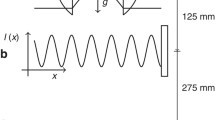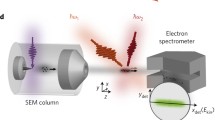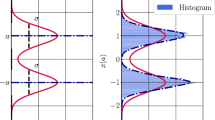Abstract
The equivalence principle of gravity is examined at the quantum level using the diffraction in time of matter waves in two ways. First, we consider a quasi-monochromatic beam of particles incident on a shutter which is removed at time \(t = 0\) and fall due to the gravitational field. The probability density exhibits a set of mass-dependent oscillations which are genuinely quantum in nature, thereby reflecting quantum violations to the weak equivalence principle, although the strong equivalence principle remains valid. We estimate the degree of violation in terms of the width of the diffraction-in-time effect. Second, motivated by the recent advances in the manipulation of ultracold atoms and neutrons as well as the experimental observation of quantum states of ultracold neutrons in the gravitational field above a flat mirror, we study the diffraction in time of a suddenly released beam of particles initially prepared in gravitational quantum bound states. In this case, we quantify the degree of violation by comparing the time of flight from the mean position of the initial wave packet versus the time of flight as measured from the mirror. We show that, in this case both the weak and strong versions of the equivalence principle are violated. We demonstrate that compatibility between equivalence principle and quantum mechanics is recovered in the macroscopic (large-mass) limit. Possible realizations with ultracold neutrons, cesium atoms and large molecules are discussed.





Similar content being viewed by others
Data availability statement
No datasets were generated or analyzed during the current study.
References
R.M. Wald, General Relativity (University of Chicago Press, Chicago, 1984)
C.M. Will, The confrontation between general relativity and experiment. Living Rev. Relativ. 4, 4 (2001). https://doi.org/10.12942/lrr-2001-4
R. Colella, A.W. Overhauser, S.A. Werner, Observation of gravitationally induced quantum interference. Phys. Rev. Lett. 34, 1472–1474 (1975). https://doi.org/10.1103/PhysRevLett.34.1472
A. Peters, K.Y. Chung, S. Chu, Measurement of gravitational acceleration by dropping atoms. Nature 400, 849–852 (1999). https://doi.org/10.1038/23655
L. Viola, R. Onofrio, Testing the equivalence principle through freely falling quantum objects. Phys. Rev. D 55, 455–462 (1997). https://doi.org/10.1103/PhysRevD.55.455
M.M. Ali, A.S. Majumdar, D. Home, A.K. Pan, On the quantum analogue of Galileo’s leaning tower experiment. Class. Quantum Gravity 23, 6493–6502 (2006). https://doi.org/10.1088/0264-9381/23/22/024
P. Chowdhury, D. Home, A.S. Majumdar, S.V. Mousavi, M.R. Mozaffari, S. Sinha, Strong quantum violation of the gravitational weak equivalence principle by a non-Gaussian wave packet. Class. Quantum Gravity 29, 025010 (2011). https://doi.org/10.1088/0264-9381/29/2/025010
R.S. Dumont, T.L. Marchioro II., Tunneling-time probability distribution. Phys. Rev. A 47, 85–97 (1993). https://doi.org/10.1103/PhysRevA.47.85
W.R. McKinnon, C.R. Leavens, Distributions of delay times and transmission times in Bohm’s causal interpretation of quantum mechanics. Phys. Rev. A 51, 2748–2757 (1995). https://doi.org/10.1103/PhysRevA.51.2748
V. Delgado, Quantum probability distribution of arrival times and probability current density. Phys. Rev. A 59, 1010–1020 (1999). https://doi.org/10.1103/PhysRevA.59.1010
C.R. Leavens, Time of arrival in quantum and Bohmian mechanics. Phys. Rev. A 58, 840–847 (1998). https://doi.org/10.1103/PhysRevA.58.840
C.R. Leavens, Arrival time distributions. Phys. Lett. A 178, 27–32 (1993). https://doi.org/10.1016/0375-9601(93)90722-C
J.G. Muga, S. Brouard, D. Macias, Time of arrival in quantum mechanics. Ann. Phys. 240, 351–366 (1995). https://doi.org/10.1006/aphy.1995.1048
P.C.W. Davies, Quantum mechanics and the equivalence principle. Class. Quantum Gravity 21, 2761–2772 (2004). https://doi.org/10.1088/0264-9381/21/11/017
P.C.W. Davies, Transit time of a freely falling quantum particle in a background gravitational field. Class. Quantum Gravity 21, 5677–5683 (2004). https://doi.org/10.1088/0264-9381/21/24/001
H. Salecker, E.P. Wigner, Quantum limitations of the measurement of space-time distances. Phys. Rev. 109, 571–577 (1958). https://doi.org/10.1103/PhysRev.109.571
A. Peres, Measurement of time by quantum clocks. Am. J. Phys. 48, 552–557 (1980). https://doi.org/10.1119/1.12061
C. Anastopoulos, B.L. Hu, Equivalence principle for quantum systems: dephasing and phase shift of free-falling particles. Class. Quantum Gravity 35, 035011 (2018). https://doi.org/10.1088/1361-6382/aaa0e8
J. Finkelstein, Ambiguities of arrival-time distributions in quantum theory. Phys. Rev. A 59, 3218–3222 (1999). https://doi.org/10.1103/PhysRevA.59.3218
J.G. Muga, C.R. Leavens, Arrival time in quantum mechanics. Phys. Rep. 338, 353–438 (2000). https://doi.org/10.1016/S0370-1573(00)00047-8
M. Moshinsky, Diffraction in time. Phys. Rev. 88, 625–631 (1952). https://doi.org/10.1103/PhysRev.88.625
P. Szriftgiser, D. Guéry-Odelin, M. Arndt, J. Dalibard, Atomic wave diffraction and interference using temporal slits. Phys. Rev. Lett. 77, 4–7 (1996). https://doi.org/10.1103/PhysRevLett.77.4
A. del Campo, G. García-Calderón, J.G. Muga, Quantum transients. Phys. Rep. 476, 1–50 (2009). https://doi.org/10.1016/j.physrep.2009.03.002
Saurya Das, Elias C. Vagenas, Universality of quantum gravity corrections. Phys. Rev. Lett. 101, 221301 (2008). https://doi.org/10.1103/PhysRevLett.101.221301
A. Martín-Ruiz, Diffraction in time of polymer particles. Phys. Rev. D 90, 125027 (2014). https://doi.org/10.1103/PhysRevD.90.125027
S. Longhi, Equivalence principle and quantum mechanics: quantum simulation with entangled photons. Opt. Lett. 43, 226–229 (2018). https://doi.org/10.1364/OL.43.000226
R.P. Feynman, A. Hibbs, Quantum Mechanics and Path Integrals. International Series in Pure and Applied Physics (McGraw-Hill, New York, 1965)
I.S. Gradshteyn, I.M. Ryzhik, in Table of Integrals, Series, and Products, 4th edn., ed. by A. Jeffrey, D. Zwillinger (Academic Press, New York, 1994)
W. Emrich, Chapter 5: Basic nuclear structure and processes, in Principles of Nuclear Rocket Propulsion. ed. by W. Emrich (Butterworth-Heinemann, Oxford, 2016), pp. 55–80
V.V. Nesvizhevsky, H.G. Börner, A.K. Petukhov, H. Abele, S. Baeßler, F.J. Rueß, T. Stöferle, A. Westphal, A.M. Gagarski, G.A. Petrov, A.V. Strelkov, Quantum states of neutrons in the earth’s gravitational field. Nature 415, 297–299 (2002). https://doi.org/10.1038/415297a
C.G. Aminoff, A.M. Steane, P. Bouyer, P. Desbiolles, J. Dalibard, C. Cohen-Tannoudji, Cesium atoms bouncing in a stable gravitational cavity. Phys. Rev. Lett. 71, 3083–3086 (1993). https://doi.org/10.1103/PhysRevLett.71.3083
M. Arndt, O. Nairz, J. Vos-Andreae, C. Keller, G. van der Zouw, A. Zeilinger, Wave-particle duality of C60 molecules. Nature 401, 680–682 (1999). https://doi.org/10.1038/44348
A. Goel, J.B. Howard, J.B. Vander Sande, Size analysis of single fullerene molecules by electron microscopy. Carbon 42, 1907–1915 (2004). https://doi.org/10.1016/j.carbon.2004.03.022
R.W. Robinett, Quantum and classical probability distributions for position and momentum. Am. J. Phys. 63, 823–832 (1995). https://doi.org/10.1119/1.17807
G. Yoder, Using classical probability functions to illuminate the relation between classical and quantum physics. Am. J. Phys. 74, 404–411 (2006). https://doi.org/10.1119/1.2173280
E.G.P. Rowe, The classical limit of quantum mechanical hydrogen radial distributions. Eur. J. Phys. 8, 81–87 (1987). https://doi.org/10.1088/0143-0807/8/2/002
J. Bernal, A. Martín-Ruiz, J. García-Melgarejo, A simple mathematical formulation of the correspondence principle. J. Mod. Phys. 4, 108 (2013). https://doi.org/10.4236/jmp.2013.41017
A. Martín-Ruiz, J. Bernal, A. Frank, A. Carbajal-Dominguez, The classical limit of the quantum Kepler problem. J. Mod. Phys. 4, 818 (2013). https://doi.org/10.4236/jmp.2013.46112
A. Martín-Ruiz, J. Bernal, A. Carbajal-Dominguez, Macroscopic quantum behaviour of periodic quantum systems. J. Mod. Phys. 5, 44 (2013). https://doi.org/10.4236/jmp.2014.51007
J.A. Cañas, J. Bernal, A. Martín-Ruiz, Exact classical limit of the quantum bouncer. Unpublished
S. Baeßler, V.V. Nesvizhevsky, G. Pignol, K.V. Protasov, AYu. Voronin, Constraints on spin-dependent short-range interactions using gravitational quantum levels of ultracold neutrons. Nucl. Instrum. Methods Phys. Res. Sect. A Accel. Spectrom. Detect. Assoc. Equip. 611, 149–152 (2009). https://doi.org/10.1016/j.nima.2009.07.048
A. Martín-Ruiz, C.A. Escobar, Testing Lorentz and CPT invariance with ultracold neutrons. Phys. Rev. D 97, 095039 (2018). https://doi.org/10.1103/PhysRevD.97.095039
C.A. Escobar, A. Martín-Ruiz, Gravitational searches for Lorentz violation with ultracold neutrons. Phys. Rev. D 99, 075032 (2019). https://doi.org/10.1103/PhysRevD.99.075032
O. Vallée, M. Soares, Airy Functions and Applications to Physics (Imperial College Press, London, 2004)
V.V. Nesvizhevsky, H. Börner, A.M. Gagarski, G.A. Petrov, A.K. Petukhov, H. Abele, S. Bäßler, T. Stöferle, S.M. Soloviev, Search for quantum states of the neutron in a gravitational field: gravitational levels. Nucl. Instrum. Methods Phys. Res. Sect. A Accel. Spectrom. Detect. Assoc. Equip. 440, 754–759 (2000). https://doi.org/10.1016/S0168-9002(99)01077-3
Acknowledgements
J.A.C. was supported by the CONACyT master fellowship No. 725033. A.M.-R. has been partially supported by DGAPA-UNAM Project No. IA102722 and by Project CONACyT (México) No. 428214. We thank to M. Cambiaso, M. J. Everitt and C. Escobar for their careful reading of the manuscript.
Author information
Authors and Affiliations
Corresponding author
Rights and permissions
About this article
Cite this article
Cañas, J.A., Bernal, J. & Martín-Ruiz, A. Testing the equivalence principle with time-diffracted free-falling quantum particles. Eur. Phys. J. Plus 137, 816 (2022). https://doi.org/10.1140/epjp/s13360-022-03051-5
Received:
Accepted:
Published:
DOI: https://doi.org/10.1140/epjp/s13360-022-03051-5




